An Illustrated Lecture
Joel F. Drinkard, Jr.
Lecture, 400th Anniversary Celebration of the King James Bible
Campbellsville University
November 10, 2011
Introduction
The year 2011 marked the 400th anniversary of the appearance of the King James Bible. This article looks back briefly at 900 years of historical Bible copying and translating, the 900 years before the King James Version, and how the Bible came to be translated in English – into the English we have come to know and understand. The quotation marks are around “English” because the earliest English was the Anglo-Saxon form of English before 1066 (the Norman conquest), which looked very little like the English used today.
The English Bible most of my generation grew up with, especially those of us raised in church, whether Baptist or other Protestant churches, and those of us where the Bible was read regularly in the home, was just one. To us “Bible” meant one thing (and only one) – a King James Bible (usually a red letter edition in which the words of Jesus were printed in red). It was the Bible used from the pulpit by pastors, the Bible used by Sunday School and Training Union teachers, and it was the only acceptable Sword Drill Bible – always the King James Bible.
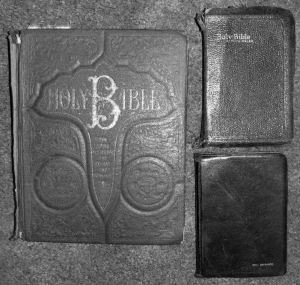
This author is old enough to remember when a new translation, the Revised Standard Version, was published in the early 1950s. Many were incensed at this translation. In the eastern part of my home state there were Bible burnings. A number of copies of this new translation were burned in public to express dissatisfaction over the new version.
And that is not the last time there was such a Bible burning, nor the last new translation to be burned. Here is a 2009 news story:
North Carolina Church plans Halloween Bible Burning
Marc Grizzard, of Amazing Grace Baptist Church in Canton, North Carolina, says that the first King James translation of the Bible is the only true declaration of God’s word, and that all others are “satanic.”
Pastor Grizzard and fourteen other members of the church plan to burn copies of the other “perversions” of Scripture on Halloween, October 31, 2009. The New Revised Version Bible, the American Standard Version Bible, and even the New King James Version are all pronounced to be works of the Devil by Pastor Grizzard and his followers.
Pastor Grizzard said: “I believe the King James version is God’s preserved, inspired, inerrant, infallible word of God… for English-speaking people. “We are burning books that we believe to be Satanic.”
As well as inappropriate translations from the original Hebrew and Aramaic, the pastor and his associates will be burning books by various authors, as well as music of every genre. “[We will be burning] books by a lot of different authors who we consider heretics, such as Billy Graham, Rick Warren… the list goes on and on,” Pastor Grizzard told reporters. Mother Teresa is also on the list of Satanic authors. The full list is available at the Amazing Grace Baptist Church‟s website.
Not all Canton residents are thrilled with the bonfire of the profanities. Judy Kirby, a local, said: “I think some of the newer versions make it easier for people to understand.” The book-burning is hoped to be a social event, with a barbecue laid on for attendees. It is not clear whether the meat will be grilled over the heat of burning Gospels.1
No doubt it would surprise Pastor Grizzard and his congregation to know that there were similar responses to the King James Bible when it first came out. Hugh Broughton, a British Hebrew scholar contemporary with the King James publication commented:
[the translation] bred in me a sadnes that will greeve me while I breath. It is so ill done. Tell his Maiest. that I would rather be rent in pieces with wilde horses then any such translation by my consent should bee urged upon poore Churches. . . . The new edition crosseth me, I require it be burnt. [all spelling sic]2
It would also likely be quite a surprise for Pastor Grizzard to learn that the King James Bible he uses is not the original 1611 translation, but a translation that has been itself updated, revised, and, yes, even corrected numerous times. And he would be even more surprised to learn that the King James Bible was not an original translation, but a revision of earlier translations that go back to the work of William Tyndale almost a century before the King James Bible. It has been estimated that 80% of the King James Bible follows the translation of Tyndale.3
The Bible in America
What was the first Bible brought to America? Most probably think of the Pilgrims who arrived in 1620/21, settled and built Plymouth colony. However, the Bible they brought with them was not the King James Bible. It was the Geneva Bible, and they brought three copies with them!4
But was that really the first Bible brought to America? What about the Jamestown colony settled in 1607 in Virginia? This colony also had strong religious convictions, but was closely aligned with the established church rather than the free- church Puritans and Pilgrims.
In the original charter granted by King James to the Virginia Company on April 10, 1606, the first motivation to colonize the New World mentioned is to spread the Christian religion … The leaders of the Virginia Company were members of the Church of England and brought the established religion with them to Jamestown … Captain John Smith tells of the settlers landing at Jamestown in 1607 and erecting a crude temporary structure to use for church services. It was made from a sail stretched among the boughs of trees, sides of rails and benches made of unhewed tree trunks. The altar was made by nailing a log to two neighboring trees as a cross bar. Later that year, the settlers built the first real church building. The settlers worshipped in it until January 1608, when it was destroyed by fire. The church was then rebuilt … This second version was probably the church in which Ann Burras, one of the first two women at Jamestown, was married later in 1608 and where her newborn daughter, Virginia Laydon, was then baptized. This may also have been the church in which Pocahontas was baptized and was later married to John Rolfe.5
Since Jamestown was so closely tied to the Church of England, its Bible would probably have been the Anglican Bible of that day, either the Bishops’ Version or the Great Bible (since the King James Bible was not completed until 1611, four years after Jamestown was settled). However, I am unable to find any definitive word on which version was used.
But wait – was Jamestown the first colony? What about Walter Raleigh’s Roanoke Island Colony. It was first settled in 1585, abandoned in 1586, and re-settled in 1587. It clearly had an Anglican priest. Its firstborn child, Virginia Dare, was christened the first Sunday after her birth. They too would probably have had the Bishops version or the Great Bible. It took three years until 1590 before additional supplies could be sent to Roanoke Island colony. When the ships brought the new supplies, the colonists had disappeared – the Lost Colony.
But this writer has to ask one more time. Was the Roanoke Island Colony the first in America? This is a little bit of a trick question. It was the first English Colony. But what about St. Augustine, settled in 1565 by the Spanish? Spanish colonies in the New World regularly included Catholic priests for converting the natives.
Having secured Spanish supremacy by defeating the French and planting a permanent colony at St. Augustine in 1565, Pedro Menéndez de Avilés tried to evangelize the Indians. He had been accompanied by four priests.
Martin Francisco Lopez de Mendoza Grajales became the first parish priest of St. Augustine, the first established parish in the United States. Pending the arrival of regular missionaries, Menéndez appointed soldiers he deemed qualified to give religious instructions to the Indians. The Jesuits were the first to arrive. Three were sent by St. Francis Borgia in 1566 and ten in 1568.6
And their Bible was undoubtedly the Latin Vulgate. So the first Bible brought to America would have been the Latin Vulgate – the standard Bible of the Catholic Church since the 4th Century.
The Bible in England
This aside was to help us recognize that the Bible of the Catholic Church, the Latin Vulgate was the first Bible in America – and it was also the first Bible in England!7 And the Vulgate and English translations of the Bible – or parts of the Bible are intertwined for nearly 900 years before the King James Bible was translated. Although there are a few scattered examples of Biblical passages cited in earlier works, the first evidence of a translation into English is in the Lindisfarne Gospels. This elaborately illuminated manuscript was apparently produced by Eadfrith, later Bishop of Lindisfarne in Northumbria, around the end of the seventh century. The text of the Lindisfarne Gospels was in the Latin of the Vulgate. In the 10th Century, Aldred, a priest, added an interlinear gloss, a word-for-word translation of the Latin into the Anglo-Saxon (old English) dialect of Northumbria.8 This is the oldest extant translation of the Gospels into English. Figure 2 shows the first words of Luke in Latin with the small interlinear words in old English.9
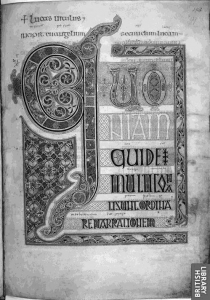
Copies of the Vulgate or portions of the Vulgate were available for those who could afford the luxury of a handwritten book, and who could read the Latin – a very small minority in medieval England. A typical manuscript of the Vulgate would have looked like the leaf pictured in Figure 3. It is a page from Numbers 24 dated to 1247 and handwritten in Paris. While not fully illuminated, this manuscript does show common decorative features of medieval manuscripts. Each chapter is indicated by Roman numerals in the text; the first word of each chapter is capitalized. Figure 4 is a leaf of an illuminated manuscript of the Book of Psalms, dated to about 1450. It shows Psalm 7:4-9 from a Book of Hours. (Books of Hours were common devotional works in the Medieval period containing biblical texts, Psalms, and prayers recited by the faithful.)
Few attempts were made to translate portions of the Bible into English during the Medieval period. The Catholic Church discouraged all vernacular translations. One significant factor that brought lasting changes to the English language and culture was the Norman Conquest in 1066.
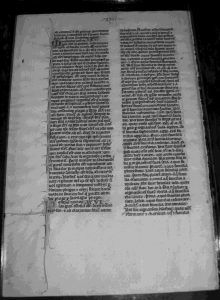
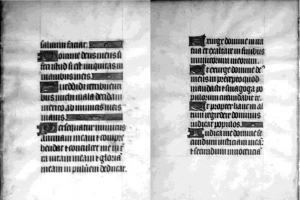
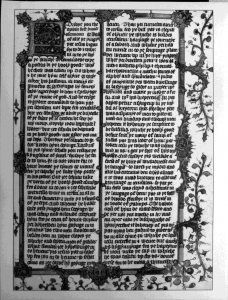
The next major force in the translation of the Bible into English was John Wycliffe. Wycliffe was an Oxford Scholar who became Master of Balliol College and Warden of Canterbury Hall. Wycliffe, aided by Nicholas of Hereford and others, undertook a translation of the Bible into English from the Latin Vulgate. The translation was the first complete English translation of the Bible. Wycliffe continued revising his translation to make the English less literal to the Latin and more readable until his death. The Church forbade one to possess or read the English Bible and other vernacular translations. The Church tried to locate and destroy every copy of Wycliffe’s translation. In 1428, 44 years after his death, on orders of the Pope, Wycliffe’s remains were exhumed and burned. Despite this, Wycliffe’s work was continued by John Purvey and others. Remembering that every copy had to be handwritten, it is remarkable that even today nearly 200 copies of the whole Bible or some smaller portion of Wycliffe Bibles remain.10 (Currently a website offers to try to locate for serious buyers a genuine Wycliffe New Testament for $2,000,000 or more.11) Figure 5 shows a replica of the beginning of the Book of Acts from Wycliffe‟s New Testament.
The invention of the printing press in 1440 by Johannes Gutenberg revolutionized the availability of written material for the populace. One of the first books printed (some pamphlets were printed earlier) was the Bible – the Latin Vulgate. It was completed in 1454. Figure 6 shows a replica page of the introduction to the Gospel of John and the beginning of John from the first edition, the 42-line printing.
Further to the east, another event occurred during this time that influenced Western Bible translations almost as much as the printing press. In 1453, the capital of the Byzantine Empire and of the Orthodox Church, Constantinople, fell to the Turks. Many scholars fled Constantinople before it fell and settled across Western Europe. They brought with them the traditions of the Eastern Church, and its reliance on the Greek Bible rather than Latin. Greek was now re-introduced in the academy in Europe and England. This new ingredient added significantly to the Reformation movement already in process.
Erasmus of Rotterdam was one of the early Western scholars to embrace the study of Greek. By 1516 Erasmus had produced a New Testament containing the Greek and Latin in parallel columns. Erasmus remained committed to Catholicism though he lived through the early period of the Reformation. His parallel New Testament was intended to be a critical edition, based on the manuscripts available to him in both Latin and Greek. His Latin version was not just a copy of the Vulgate, but was his own translation and compilation from the manuscripts. Although not a true critical edition, his
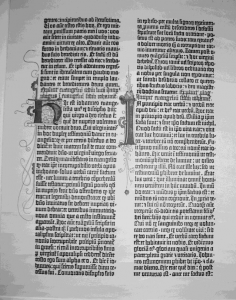
publication made the Greek available to scholars producing vernacular translations. Martin Luther used Erasmus’ Greek as the basis for his German translation and Tyndale used it for his English translation. Figure 7 of Erasmus’ text is from a compact disc of a facsimile edition of his 1516 Greek-Latin New Testament.
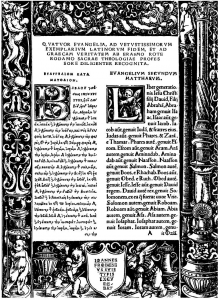
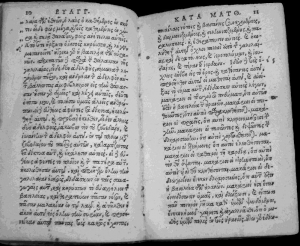
One of the significant editions of the Greek New Testament after Erasmus was that published by Robert Stephanus in Paris in 1551. This edition became the basis of the so-called “textus receptus.” The pages depicted in Figure 8 are from the 1569 edition printed by his son Robert Stephanus, Jr. Matthew 4-5 is shown including the Beatitudes. The “textus receptus” was the primary Greek text used by the translators of the Geneva Bible and the King James Bible.
Among the Hebrew materials available to 16th Century translators would have been Jewish Torah Scrolls such as the fragment of Genesis shown in Figure 9. (This scroll is only 300-400 years old; too recent to have been used by 16th-Century translators.) Figure 10 is a page of a Hebrew Bible also printed by Robert Stephanus. This page shows Deuteronomy 4 from a 1544 edition printed by Robert Stephanus, Sr.
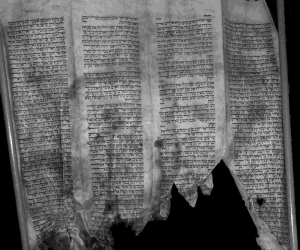
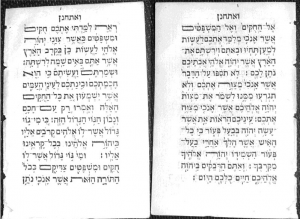
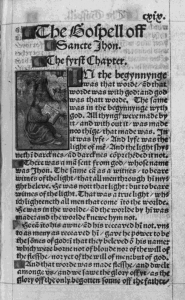
While Wycliffe did not work from original language texts (Greek and Hebrew), Tyndale did. His translation of the New Testament was the first English translation from the Greek rather than the Latin. But in England, it was still a crime to translate the Bible into English without Church or royal permission. Tyndale fled to Europe and translated the New Testament by 1526 in Germany. He continued revising the New Testament and completed the Old Testament Pentateuch in 1530. He was betrayed and imprisoned in 1535 and martyred in 1536 before completing the Old Testament. In a letter written from prison, he asks that he be allowed to have his Hebrew Bible, grammar and lexicon, clearly showing he used Hebrew materials in translating the Old Testament.12 Figure 11 shows a photo of Tyndale‟s first edition New Testament of 1526.
Tyndale’s work was carried on and completed by several followers, including Myles Coverdale and John Rogers. Coverdale completed a translation of the complete Bible in 1535. Because he was not proficient in Greek or Hebrew, Coverdale relied primarily on Tyndale’s version for the materials Tyndale had completed. For the rest he used the Latin Vulgate and Luther‟s German translation. In 1538, Coverdale published a Latin-English diglot. His purpose was to show that his English New Testament did not differ theologically from the Latin Vulgate. However, this leaf from Colossians 1 has one of the significant variants in Coverdale that incensed many Church authorities (Figure 12). Coverdale translated the Greek ekklesia in Colossians 1:18 as “congregation” rather than “Church.” “Congregation” was a word favored by many of the free church tradition; “church” was the traditional translation and the word favored by Catholic and Anglican translators.
Rogers produced a complete translation of the Bible in 1537 under the pseudonym of Thomas Matthews. The translation was largely that of Tyndale and Coverdale with numerous revisions of his own. The Matthews version shown in Figure 13 was published in 1549. It was the first English translation to receive royal license from Henry VIII. This version could legally be printed and sold in England. However, when the Catholic Mary I succeeded Edward VI as Queen in 1553, persecution of Protestants once
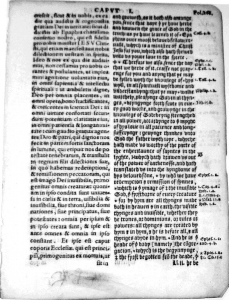
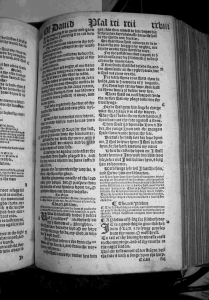
again followed. Rogers was the first martyr in 1555; a total of 280 were burned at stake during her five-year reign.
Coverdale was also the leading figure in the production of the “Great Bible” in 1539, a translation that also received Henry VIII’s license and the 1540 edition that contained Thomas Cranmer’s preface. The name “Great Bible” refers to its large size, each page is 14 by 9 inches. Figure 14 of the Great Bible shows 2 Kings 9-10 describing the death of Jezebel and the 70 sons of Ahab.
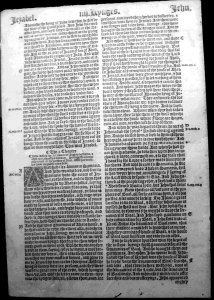
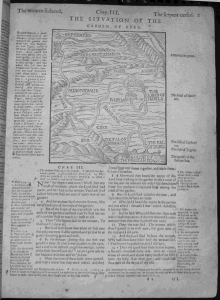
During the reign of Mary I, many Protestants fled to Europe. A significant number settled in Geneva and came under the influence of John Calvin. There they produced an English translation that became extremely popular, the Geneva Bible, also called the “Breeches Bible”: from its translation of Genesis 3:7: “Then the eyes of them both were opened, and they knew they were naked; and they sewed figge tree leaves together, and made themselves breeches.” The Geneva Bible became so popular in part due to
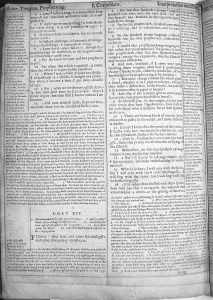
its compact size and its use of the very readable roman type. Both features made it the first Bible affordable to many lay people in England, rather than just the wealthy. In addition, the marginal notes expressing Calvin‟s theology was very popular among many Protestants. Figure 15 shows Genesis 3 from a 1599 edition and Figure 16 shows 1 Corinthians 13 from an earlier 1581 edition. Notable in 1 Corinthians 13 is the repeated translation of the Greek agape as “love” as had been used also by Tyndale and Coverdale in the Great Bible. The Geneva Bible was the Bible used by Shakespeare, John Bunyan, John Milton, and John Donne, and was the one brought to America by the Pilgrims.
The popularity of the Geneva Bible in England led Anglican Church leaders to produce a new translation to be used in churches which would be free from its Reformed doctrine, especially evident in the notes. The result was the Bishops’ Version, a large pulpit Bible that was to be placed in every parish Church and Chapel. The Bishops’ Version was largely a revision of the Great Bible, but in a number of ways it followed the Latin Vulgate rather than the Greek that Tyndale and Coverdale had used for the New Testament. One clear example of this is found in 1 Corinthians 13. The first edition of the Bishops’ Version printed in 1568 followed the Great Bible by translating agape as “love.” But all subsequent editions beginning in 1572 follow the Latin Vulgate, which uses caritas consistently in 1 Corinthians 13. The later Bishops’ Versions, including the one pictured in Figure 17, a 1591 printing, translate the Greek agape as “charitie,” a pattern also followed by the King James Bible.
The Catholic community in England finally produced an English translation of the New Testament in 1582, translated at Rheims, France. This was followed by the Old Testament translation at Douay, France in 1609. The Rheims New Testament also translates the Greek agape of 1 Corinthians 13 as “charitie.” Pictured in Figure 18 is the Rheims New Testament from a Rheims-Bishops’ parallel New Testament published in 1601. The text shown has the account of the Last Supper from Mark 14:22-26. The Rheims version is in the left column, the Bishops’ version is on the right.
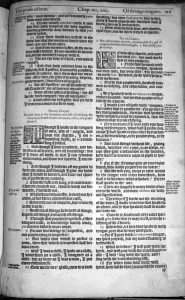
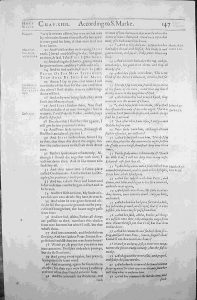
This brings us to the King James Bible. In 1604, King James I commissioned a team of nearly fifty scholars to produce a new translation of the Bible. One significant factor in his decision was the popularity of the Geneva Bible with its Reformed-Calvinistic marginal notes. James I wanted a translation free from such notes. The work was completed in 1611. Although about 80% of the new translation derived from Tyndale, the King James Bible had a much more readable and poetic quality. It was clearly intended to be read aloud and to be preached. In many respects it is that poetic quality, a rhythmic cadence of the spoken words that even today sets the King James Bible apart from other more modern translations. Figure 19 shows a leaf from a 1611 edition of Zechariah 9. In this passage we find the verse quoted in Matthew 21 on Palm Sunday from Zechariah 9:9: “Rejoice greatly, O daughter of Zion; shout, O daughter of Jerusalem: behold, thy King cometh unto thee: he [is] just, and having salvation; lowly, and riding upon an ass, and upon a colt the foal of an ass.”
The King James Bible, even in the first edition, was not a perfect translation. There were variant readings and even errors in that first edition. Apparently multiple presses were used to meet the demand to print sufficient copies for every church in England, and sheets for each Bible came from many sources. One notable variant in the 1611 printings is found in Ruth 3:15 giving the name to two Bibles as “He Bible” and “She Bible.” The question becomes, which did the original translators intend to say?:
14 And she lay at his feet until the morning: and she rose up before one could know another. And he said, Let it not be known that a woman came into the floor. 15Also he said, Bring the vail that [thou hast] upon thee, and hold it. And when she held it, he measured six [measures] of barley, and laid [it] on her: and he/she went into the city. 16And when she came to her mother in law, she said, Who [art] thou, my daughter? And she told her all that the man had done to her.
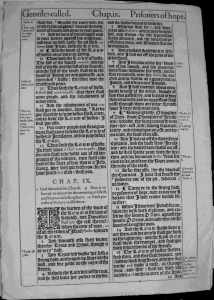
The one edition reads “he went into the city,” the other reads “she went into the city.” There is no consensus concerning which translation the original translators adopted. On one hand the context seems to favor “she” because “she” is the subject in what follows. In addition, the Latin Vulgate reads “she.” However, the primary Hebrew evidence supports “he.” Among earlier English translations, one finds that the Matthews version, Geneva Bible, and Bishops version all follow the Vulgate and read “she went into the city.” Figure 20 is from a reprint of the 1611 “He” Bible published by Hendrickson Publishers. It shows the passage from Ruth 3. Also, the 1630 Cambridge printing of King James Bible reads “she went into the city” (Figure 21).
A couple of significant printing errors in the 1611 editions of the King James Bible may be mentioned. The “She” Bible reads at Matthew 26:36: “Then cometh Judas with them unto a place called Gethsemane, and saith unto the disciples, Sit ye here, while I go and pray yonder.” The text should read “then cometh Jesus.” Judas had already committed suicide by this time. Another error is found in Exodus 14:10 in the 1611 edition (Figure 22), which repeats 3 lines:
And when Pharaoh drew nigh,
the children of Israel lift up their eyes,
and behold, the Egyptians marched after them, and they were sore afraid: and
the children of Israel lift up their eyes,
and behold, the Egyptians marched after them, and they were sore afraid: and
the children of Israel cried out unto the Lord.
One other printing error of the 1611 “He” Bible is found at Jeremiah 49:1 which reads:
“Concerning the Ammonites, thus sayth the Lord; Hath Israel no sonnes? hath he no heire? Why then doth their king inherit God, and his people dwell in his cities?”
The correct reading is: “Why then doth their king inherit Gad…?” These two readings are seen in photos from the reprint of the 1611 “He” Bible and the 1630 Cambridge edition.
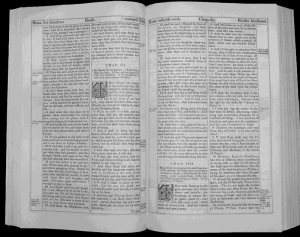
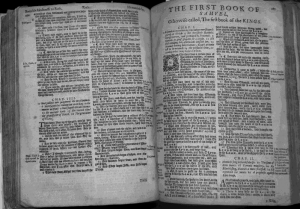
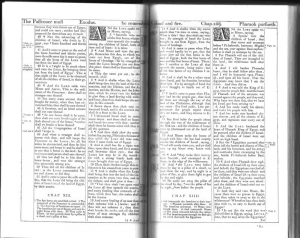
The King James Bible did not receive full acceptance with the general populace at first. For several decades the Geneva Bible was still preferred by many, especially free church Protestants. However with every passing decade, the King James Bible became the dominant translation for the English- speaking world. And it has held that place for 400 years. For over 250 years, few new English translations appeared. During this same period, the King James Bible itself underwent many revisions. Seventeenth-century spelling was modernized; grammar was updated. But the beauty of the language, the poetic quality, the readability has remained and kept the King James Bible a best-seller.
The last century witnessed an exponential growth of new translations, paraphrases, and special editions of Bibles and Bible portions. Today, there are literally hundreds of options for English Bible editions in print, digital, and audio formats. If you have a smart phone, or a tablet, there’s an “app” for your favorite Bible. With all these choices, the monopoly of the King James Bible is in serious jeopardy. Many of the new translations offer improved readings based on better Hebrew and Greek texts now available. Others offer a more readable English prose that focuses less on literal translation than on capturing the intention of the original languages. Still others paraphrase the original languages in colloquial English. They are simply new ways of packaging “the old, old story.” So long as the new versions communicate effectively the Gospel, “the old, old story,” “the faith which was once delivered unto the saints,” we need not fear these new Bibles. On a personal note, I find more and more in my ministry, I am called upon to use the King James Bible primarily at the funerals of those of my generation and older, those for whom the King James Bible was the only Bible. Its familiar words provide a source of strength and comfort to us. If in the future the King James Bible is replaced as “the Bible” for the English-speaking world, may its epitaph include its own words:
“Well done thou good and faithful servant” (Matthew 25:21).
Bible Exhibit (Editor’s Note)
An exhibit of Bibles from Dr. Drinkard’s personal collection was displayed in Montgomery Library from September 22 to December 1, 2011. Items exhibited were:
Leaf, Latin Bible, Paris, 1247
Leaf, Latin Bible, Venice, 1483
Leaf, Coverdale Latin-English, 1538
Matthew‟s Version, 1549
Beza, Greek, and Latin, 1565, Henricus Stephanus
Leaf, Bishop‟s Bible, first edition, 1568
Geneva Bible, 1599
Jewish Scroll, part of the book of Esther, between 200-300 years old
Bishop‟s Bible, 1591
Leaf, Great Bible, 1540
Leaf, Greek-German-Latin Bible, 1596
Bishops-Rheims Parallel Bible, 1601
Leaf, King James Psalter, 1612
Leaf, King James Bible, 1611, first edition
Endnotes
1 Tom Chives, “North Carolina Church Plans Halloween Bible Burning,” The Telegraph, October 16, 2009. http://www.telegraph.co.uk/news/religion/6346662/North-Carolina-church-plans-Halloween-Bible-burning.html (accessed January 18, 2012).
2 Hugh Broughton, “A Censure of the Late Translation for our Churches, 1611,” found in Folger Shakespeare Library http://luna.folger.edu/luna/servlet/view/search;jsessionid=%2084F594CF091BD5F13FF294139E9A4C3?%20QuickSearchA=QuickSearchA&q=Broughton%2C+Censure&sort=Call_Number%2C%20Author%2CCD_Title%2CImprint&search=Search accessed January 18, 2012.
3 Donald Brake, A Visual History of the English Bible (Grand Rapids, MI: Baker, 2008), 106, suggests “that 80 to 90 percent of the King James Version is the direct expression of Tyndale.”
4 Philip C. Stine, “The King James Version Then and Now,” Review & Expositor 103 n2 (Spring 2011), 204.
5 Archibald Andrews Marks, “Religion at Jamestown,” in “Jamestown and Yorktown Settlement Victory Center” [Williamsburg, Virgina] http://historyisfun.org/pdf/background-essays/religionatjamestown.pdf; accessed January 18, 2012.
6 en.wikipedia.org/wiki/Roman_Catholic_Diocese_of_St._Augustine. Accessed 1/18/2012.
7 F. F. Bruce, History of the Bible in English, 3rd ed. (New York: Oxford University Press, 1978), 1.
8 Ibid., 7-8.
9 The manuscript is currently located in the British Library.
10 Henry Hargreaves, “ The Vernacular Scriptures 3. The Wyciffite Versions,” in The Cambridge History of the Bible, Volume 2, The West from the Fathers to the Reformation, ed. G. W. H. Lampe (Cambridge: Cambridge University Press, 1969), 388.
11 “Greatsicom: World’s Largest Dealer of Rare and Antique Bibles” www.greatsite.com/ancient-rare-bibles-books/platinum.html accessed (January 18, 2012).
12 Herbert Gordon May, Our English Bible in the Making (Philadelphia: Westminster Press, 1952), 25. A photo-engraving of the actual letter may be found as the frontispiece of William Tyndale’s Five Books of Moses Called the Pentateuch Being a Verbatim Reprint of the Edition of CCCCC.XXX (Fontwell, Sussex: Centaur Press, 1967).
Photographic Credits:
All the Bibles and Bible pages displayed in this article were photographed by the author from his own collection except for those listed below:
Lindisfarne Gospels, Luke.
Located in the British Library. Public domain photo located online at: https://en.wikipedia.org/wiki/File:Lindisfarne_Gospels_folio_139r.jpg (accessed January 18, 2012).
Erasmus‟ 1516 Latin-Greek New Testament.
Photo of page from a compact disc published by Reformed Church Publications. Available at www.reformedchurchpublications.org.
Tyndale 1526 New Testament
Located in the British Library. Public domain photo located online at: https://en.wikipedia.org/wiki/File:Tyndale_Bible_-_Gospel_of_John.jpg (accessed January 18, 2012).
King James Bible 1611
Ruth 3-4, Exodus 13-14 and Jeremiah 49 from the Hendrickson Publishers reprint published in 2003. (I photographed these pages from my copy of the Hendrickson edition.)
